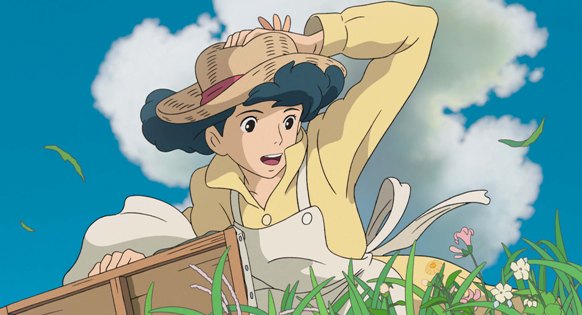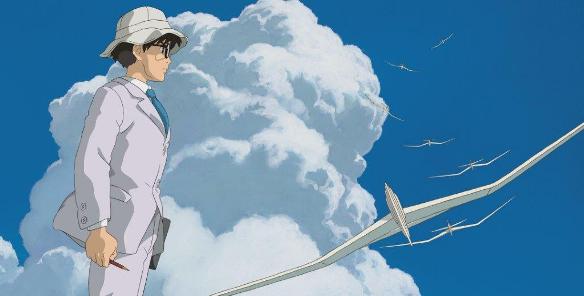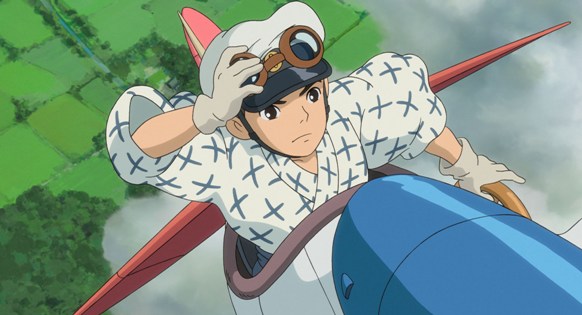The wind rises, we must try to live. It is a call to action, a place for beginnings, rather than farewells. Hayao Miyazaki’s last film, The Wind Rises, takes its title from a line in Paul Valéry’s poem Le cimetière marin. (Read the translation by C. Day Lewis ). Drawn to the peaceful promise of the grave and the vast ocean of immortality, the poet turns away, his spirit revived by the winds, calling out: “Le vent se lève! . . . il faut tenter de vivre!” The wind rises, we must try to live.
Miyazaki – the animator, manga artist, storyteller, film director, writer, producer and co-founder of Studio Ghibli, has created imaginative and beautifully detailed stories and worlds that seem to exist in a genre of their own. Princess Mononoke (1997) was his first film to awaken widespread international interest, and Spirited Away (2001) was the first anime film to win an American Academy Award. In Miyazaki’s films the world he depicts is not without pain or peril, but it is a world in which even the most ordinary and outwardly vulnerable protagonists show great courage, it is a world that admits the possibility of tenderness.
At first glance, The Wind Rises seems to differ from Miyazaki’s previous films. Rather than an invented story, the film is based on the biography of Jiro Horikoshi (1903 – 1982), who designed the fighter aircraft used by Japan during World War II: the Mitsubishi A5M and Mitsubishi A6M Zero. Yet that description barely touches the surface of the film. Jiro’s story provides the framework through which Miyazaki weaves an epic tale, a powerful metaphor and the story of a courageous young girl. 風立ちぬ – Kaze Tachinu (which is the name of Miyazaki’s film in Japanese) is also the name of a short story written by Tatsuo Hori in 1937, and this fictional story, about a woman in a tuberculosis sanatorium, is an integral part of the tale Miyazaki wishes to tell.

Wind, flight, spirit, breath – this is the heartbeat, the rhythm that connects perhaps all of Miyazaki’s films. His love of flight is a signature element of Miyazaki’s films (Porco Rosso, My Neighbor Totoro, Spirited Away, and Howl’s Moving Castle all have flight scenes, just to name a few), and the focus on Jiro is logical. Yet I feel that the film conveys much more on a symbolic level, creating an identification between flight and artistic creation, the willingness to take risks, the desire to soar. Jiro, the boy in spectacles who dreams of flight, is perhaps the more famous protagonist, but Naoko, the spirited young girl he meets on the train, is just as central to the film’s message. After all, she is the one who first quotes Valéry.
Miyazaki’s final film may also been seen as a farewell and a tribute to his home, to Japan. Set in an era before his own time (the film begins in Jiros’s childhood, about 1918), The Wind Rises tells of Japan’s past in lovingly detailed scenes. There is great empathy here for the land, its haunting, enchanted landscapes, its people, and their suffering. The juxtaposition of past and present, the tensions and symbiotic connection between the ancient history and culture of Japan and its contemporary cutting edge design and technology is conveyed in a brief, wordless scene, as a pair of oxen pull a Zero plane to the testing area.
Heavier in its subject and associations, and more deliberate and long-winded in its style, The Wind Rises is not without its moments of fancy and exquisite beauty. Young Jiro’s dream of a flying machine is an incredible contraption – part steam kettle and part bird. A single image of Jiro as a young man, his features against the background of a sky suffused with golden light, has all the ethereal beauty of a dream. The film feels like a loving look at all that Miyazaki loves: flight, dreams, brave girls, and art in all its many forms. There are references to Beethoven, Schubert’s Winter Journey, Thomas Mann, and a quotation from Christina Rossetti: “Who has seen the wind?/Neither I nor you:/But when the leaves are trembling/The wind is passing through.”
Jiro’s biography gives the film its narrative frame, yet having seen the film, I feel that it is as much about the desire and struggle to create art, as it is about aviation. To the extent that one might criticize the film for lauding someone who made weapons of war, I feel that Miyazaki makes his point early on, establishing Jiro as someone who strives for justice and has empathy towards his fellow man. The burning desire to design an aircraft, and the compromise that makes him part of the war machine raises the kind of decisions that we all confront on different levels, decisions that we sometimes make without even acknowledging their existence. As his mentor Caproni tells Jiro in the film “airplanes are beautiful dreams,” and in the translation of dream to reality, much can and usually does, change. What is to be done? The wind rises, we must try to live.
The Wind Rises will be the closing film of the Jerusalem Film Festival 2014, which will also host a tribute to Miyazaki with screenings of Castle in the Sky, Howl’s Moving Castle, Kiki’s Delivery Service and My Neighbor Totoro.
The Wind Rises is schedule for theatrical release in Israel, distribted by Orlando Films, on July 17th.
The Wind Rises (Japan, 126 min, 2014, Japanese with Hebrew and English subtitles)
Written and directed by Hayao Miyazaki








